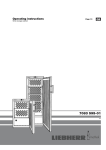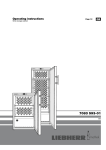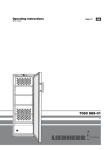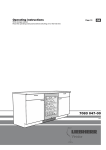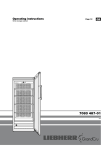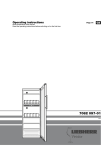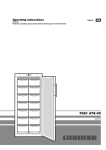Download Liebherr G 2433 freezer
Transcript
Operating instructions Freezer
Page 8
GB
7082 327-00
G_33 910
Disposal notes
• Keep packaging materials away from children - polythene
sheets and bags can cause suffocation!
• Please return the packaging to an official collection point.
Your old appliance: This contains some reusable materials
and should be disposed of properly - not simply with unsorted
household refuse.
• Discarded appliances should be disabled: Remove the
plug, cut through the connection cable and render the
catch unusable so that children cannot become trapped
inside.
• Ensure that the refrigerant circuit is not damaged when
the appliance that is no longer needed is taken away
for disposal.
• Details of the refrigerant can be found on the type plate.
• Appliances which are no longer needed must be disposed of in a
professional and appropriate way, in accordance with the current
local regulations and laws.
Range of appliance use
The appliance is suited only for cooling food. In the case of commercial food cooling, the pertinent statutory regulations have to
be observed.
The appliance is not suited for storing and cooling pharmaceuticals,
blood plasma, laboratory preparations or similar substances and
products subject to the Medical Devices Directive 2007/47/EC.
Any misuse of the appliance may result in damage to or spoilage
of the stored goods.
Furthermore, the appliance is unsuited for use in areas exposed
to an explosion hazard.
Description of appliance and equipment
Operating and
control elements
Type plate
Drawers
Freezing chart
Safety instructions and warnings
• To prevent injury or damage to the unit, the appliance should be
unpacked and set up by two people.
• In the event that the appliance is damaged on delivery, contact
the supplier immediately before connecting to the mains.
• To guarantee safe operation, ensure that the appliance is set up
and connected as described in these operating instructions.
• Disconnect the appliance from the mains if any fault occurs. Pull
out the plug, switch off or remove the fuse.
• When disconnecting the appliance, pull on the plug, not on the
cable.
• Any repairs and work on the appliance should only be carried
out by the customer service department, as unauthorised work
could prove highly dangerous for the user. The same applies to
changing the mains power cable.
• Do not allow naked flames or ignition sources to enter the appliance. When transporting and cleaning the appliance ensure that
the refrigerant circuit is not damaged. In the event of damage,
make sure that there are no ignition sources nearby and keep the
room well ventilated.
• Do not stand on the plinth, drawers or doors or use them to support anything else.
• This appliance is not intended for use by persons (including children) with reduced physical, sensory or mental capabilities or lack
of experience and knowledge unless they have been given initial
supervision or instruction concerning use of the appliance by a
person responsible for their safety. Children should be supervised
to ensure that they do not play with the appliance.
• Avoid prolonged skin contact with cold surfaces or chilled/frozen
food. This could cause pain, numbness and frostbite. In the case
of prolonged skin contact, protective measures should be taken,
e.g. gloves should be worn.
• Do not eat ice cream, particulary ice lollies or ice cubes, immediately after taking them from the freezer compartment as there
is a risk of "burning" because of the very cold temperatures.
• Do not consume food which has been stored for too long, as it
could cause food poisoning.
• The appliance is designed for cooling, freezing and storage of
food, and for making ice and is intended for domestic use. If used
for commercial purposes, the relevant legal regulations applicable
to the trade concerned must be observed.
• Do not store explosives or sprays using combustible propellants
such as butane, propane, pentane etc. in the appliance. Electrical
components might cause leaking gas to ignite. You may identify
such sprays by the printed contents or a flame symbol.
• Do not use electrical appliances inside the appliance.
• The appliance is designed for use in enclosed areas. Do not
operate the appliance outdoors or in areas where it is exposed
to splash water or damp conditions.
Climate rating
The appliance is set to operate within specific ambient temperature
limits according to its climate rating. These temperature limits should
not be exceeded. The correct climate rating for your appliance is
indicated on the type plate.
Climate rating
Adjustable-height feet
8
SN
N
ST
T
Ambient temperature
+10°C to +32°C
+16°C to +32°C
+16°C to +38°C
+16°C to +43°C
Setting up
• Do not place the appliance in direct sunlight or near cookers,
radiators and similar sources of heat.
• The floor on which the appliance stands should be horizontal and
level. To compensate for any unevenness, adjust the height of the
feet with the open-ended spanner supplied.
• Always ensure good ventilation. Do not cover ventilation openings
or grille.
• Do not place heat-emitting appliances, e.g. microwave oven,
toaster, etc., on top of the freezer.
• Standard EN 378 specifies that the room in which you install your
appliance must have a volume of 1 m3 per 8 g of R 600a refrigerant
used in the appliance, so as to avoid the formation of inflammable
gas/air mixtures in the room where the appliance is located in the
event of a leak in the refrigerant circuit. The quantity of refrigerant
used in your appliance is indicated on the type plate on the inside
of the appliance.
• Do not connect the appliance to the supply with other equipment
using an extension cable - risk of overheating.
Operating and control elements
3
Power supply (AC) and voltage at the operating point must comply
with the details on the type plate, which is located on the inside
left of the appliance. The socket must be fused with a 10 A fuse
or higher, it must be away from the rear of the appliance and must
be easily accessible.
Connect the appliance with a properly earthed fused plug
and socket only.
Dimensions (mm)
4
2
5
1
1 Temperature display (display)
2 Temperature button
3 On/Off button
4 SuperFrost button
5 Audible warning on/off button
Connecting to the mains
GB
Setup mode is activated (activating the child lock and
adjusting the display brightness)
Alarm (symbol flashes if the temperature inside the appliance is too high)
Child lock is activated
SuperFrost is on
Adjusting the display brightness (this symbol is only activated in setup mode)
Demo mode is activated
Switching the appliance on and off
Switching on: Press the ON/OFF button so that the
temperature display lights up/flashes.
G 20 G 24
G 27
H = 1250 mm
H = 1447 mm
H = 1644 mm
Switching off: Press the ON/OFF button for approx. 3
seconds so that the temperature display goes out.
Setting the temperature
Press the Up/Down button, the next lower
temperature value in the temperature display will light up.
Keep pressing the Up/Down button until
the desired value is displayed.
Saving energy
- Always ensure good ventilation. Do not cover ventilation openings
or grille.
- Do not place the appliance in direct sunlight or near cookers,
radiators and similar sources of heat.
- The energy consumption depends on the installation conditions,
e.g. the ambient temperature.
- Keep the time the appliance is open to a minimum.
- Store food logically.
- Keep all food properly packed and covered so as to avoid its
frosting up on the outside.
- Always allow hot food to cool to room temperature before placing
in the appliance.
- If there is a thick layer of frost in the appliance: defrost the appliance.
Accumulated dust increases the energy consumption:
- Once a year, dust the refrigeration unit together with the metal
grid of the heat exchanger at the back of the appliance.
Note
After a certain period of operation, the interior temperature will
adjust to the value which has been set.
Audible warning signal
It sounds when it is not cold enough in the freezer compartment.
The temperature display and the symbol
flash.
The audible warning device is switched off by pressing the
ALARM button. The temperature display will continue to
flash until the cause of the alarm has been rectified.
This can be caused by:
• the freezer door being left open for a long time, allowing warm
ambient air to enter;
• a long power failure;
• a fault in the appliance.
In each case, make sure food has not thawed or perished.
9
Additional functions
In set-up mode you can set the child lock and adjust the brightness
of the display. The child lock is designed to protect the appliance
from being switched off accidentally.
Activating the child lock
Adjusting the display brightness
Press
Press
for 5 seconds. Display =
Display =
Display =
Display =
Display =
Display =
Adjust to the desired brightness using the Up/Down
button.
The child lock is activated.
Deactivating the child lock
Press
for 5 seconds. Display =
for 5 seconds. Display =
Display =
Display =
Display =
The child lock is deactivated.
Display =
The adjusted brightness will be activated after one
minute.
Note: If a button is pressed, the display lights up for one minute at
maximum brightness.
Demo mode
Demo mode can be activated for presenting the appliance at exhibitions or in salesrooms as though in normal operating mode.
DEMO appears in the display.
When in this mode, the cooling circuit is switched off!
If this mode is activated by accident, it can be deactivated as
detailed below.
+
Press
MENU and
for 5 seconds.
will flash in the display.
If the cursor in the temperature display is at -25°C, continue with the
next point. If not, adjust to this position using the Up/Down button.
The display is switched off for 1 second.
The appliance is then back in normal operating mode.
10
Freezing
The maximum amount of food (in kg)
which can be frozen in 24 hours is
shown on the type plate ("Freezing
capacity").
SuperFrost
By activating the SuperFrost function the temperature in
the freezer compartment will drop to the lowest attainable
value. Thus food can be rapidly frozen to the core and
the quality is preserved.
• Press the SuperFrost button. The symbol
appears in the
display.
• Wait 24 hours.
• Place the fresh food in the freezer.
• The automatic SuperFrost system automatically switches the fast
freezing procedure off after 65 hours.
You should not switch on the SuperFrost function:
- when placing frozen food in the freezer;
- when freezing up to approx. 2 kg fresh food daily.
Notes on freezing and storage
Equipment
GB
Freezing chart
The freezing chart represents
the frozen food and the time it
can be safely stored in months.
The individual storage times
and whether or not the lower
or upper value is applicable
depend on the food quality, its
processing prior to freezing,
and the individual household's
quality requirements.
The lower values always apply
to food with a high fat content.
Cold-storage accumulators
The cold-storage accumulators provided
prevent the temperature in the freezer
from rising too quickly in the event of
a power failure.
To ensure maximum storage time in
the event of a power failure, place
the cold-storage accumulators in the
top-most freezer d
rawer on top of the food.
• Always store identical food items together.
• Pack food which you are freezing yourself in quantities appropriate
to your household. To ensure that the food freezes right through,
the following quantities should not be exceeded per package:
fruit, vegetables: up to 1 kg, meat: up to 2.5 kg.
• Pack frozen food in standard freezer bags or reuseable plastic,
metal or aluminium containers.
• Do not allow fresh food which is to be frozen to come into contact
with food already frozen. Always keep packs dry in order to avoid
them sticking together.
• Always write the date and contents on the pack and do not exceed
the stated storage time for the food.
• Do not freeze bottles and cans which contain carbonated drinks
as they might burst.
• Only take out as much food as is immediately required for thawing.
Use food which has been thawed in prepared meals as quickly
as possible.
Frozen food can be thawed in the following ways:
–in a fan oven
–in a microwave oven
–at room temperature
–in the refrigerator: the cold given off by the frozen food is used for
cooling.
11
Defrosting
After the appliance has been in operation for some time, a layer
of frost or ice will form on the inside walls. This increases energy
consumption.
Caution!
Defrost the appliance as soon as the ice thickness is 5 mm.
Otherwise, the drawers cannot be opened and might become
damaged.
• Switch the appliance off to defrost. Pull out the mains plug.
• Remove the drawers and glass shelves.
• Wrap the frozen food in paper or blankets and store in a cool place.
• To speed up the defrosting process put a saucepan of hot water
on the compartment floor.
• Leave the door of the appliance open while defrosting. After
defrosting mop up the remaining water and clean the appliance.
Do not use any mechanical devices or other artificial aids for
defrosting other than those recommended by the manufacturer.
Cleaning
Before cleaning always switch off the appliance. Pull out the
mains plug or switch off or unscrew the fuse.
Clean the inside, equipment and outer walls with lukewarm water
and a little detergent. Do not use abrasive or acid cleaners or
chemical solvents.
Do not use steam cleaners because of the risk of injury and
damage.
• Ensure that no cleaning water penetrates into the electrical components or ventilation grille.
• Dry all parts well with a cloth.
• The dust should be removed from the refrigeration unit and heat
exchanger - metal grid at the back of the appliance - once a year.
• Do not damage or remove the type plate on the inside of the appliance. It is very important for servicing purposes.
Malfunctions
You may be able to rectify the following faults by checking
the possible causes yourself:
Appliance does not function:
–Is the appliance switched on?
–Is the plug correctly fitted in the mains socket?
–Is the fuse intact?
Loud running noise:
–Is the appliance set up firmly on the floor?
–Does the appliance cause nearby items of furniture or objects to
vibrate? Please note that noises caused by the refrigerant circuit
cannot be avoided.
The temperature is not low enough:
–Is the temperature setting correct (see "Setting the temperature")?
–Have excessive amounts of fresh food been placed in the appliance?
– Does the separately installed thermometer show the correct reading?
– Is the ventilation system working properly?
– Is the appliance set up too close to a heat source?
If none of the above causes apply
and you cannot rectify the fault
yourself, contact the nearest
customer service department
stating the type designation ➊,
service number ➋ and appliance
number ➌ as indicated on the type
plate. The type plate is located on
the inside left of the appliance.
Shutting your appliance down
If your appliance is to be shut down for any length of time, switch
it off and disconnect the plug or switch off or unscrew the fuse.
Clean the appliance and leave the door open in order to prevent
unpleasant smells.
The appliance complies with the relevant safety regulations and
EC Directives 2004/108/EC and 2006/95/EC.
All types and models are subject to continuous improvement and
the manufacturer therefore reserves the right to make modifica
tions to the shape, equipment and technology.
12
GB
Changing over door hinges
Door hinges should only be changed by a trained expert.
Changing the door hinges must be done by two people.
10. Transfer cover plate to the opposite side.
10.
11. Screw hinge bracket into place.
11.
1. Remove covers.
1.
12.
12. Transfer upper hinge components to the opposite side.
2. Tilt appliance slightly backwards and pull out hinge pin.
3. Remove spacer.
3.
2.
13. Mount door on hinge pin and close.
13.
4. Remove the door.
4.
5.
5. Transfer plug.
6. Lever out pressure plates at the
front and slide away.
7. Transfer door handle and plugs
to the other side.
14. Insert spacer.
14.
15. Tilt appliance slightly backwards and insert hinge pin.
7.
15.
6.
8. Transfer spring clip to the opposite side.
8.
9. Transfer the hinge component on the
hinge bracket to the opposite side.
9.
16. Click covers into place.
16.
13










